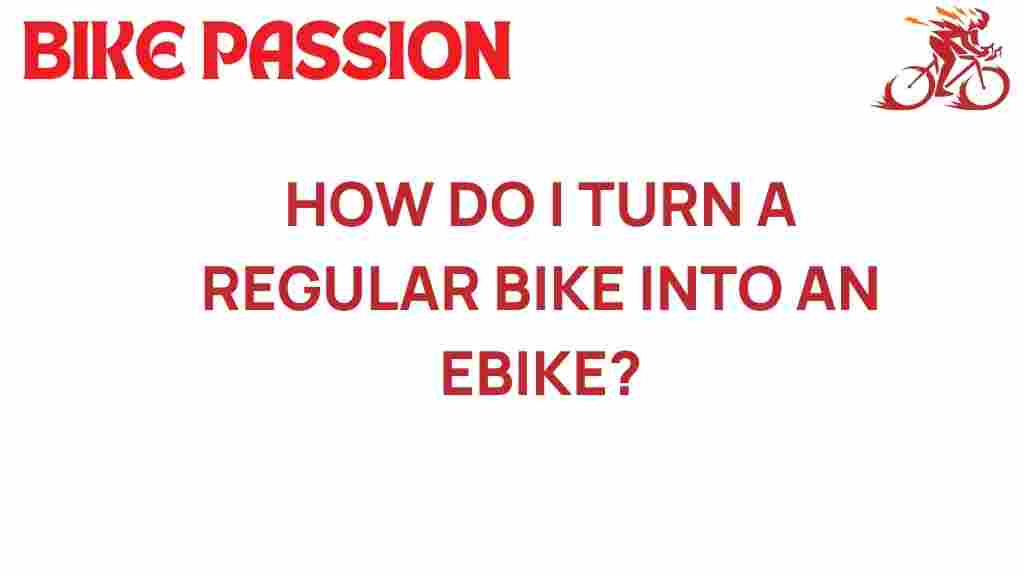e-bike conversion: Transform Your Ride
As the world moves towards more sustainable transport solutions, many cyclists are considering how to integrate electric bikes into their lives. An e-bike conversion is a fantastic way to transform your regular bicycle into an electric bike, allowing you to enjoy the benefits of biking with less effort. This guide will walk you through the process of converting your bike into an electric bike, focusing on DIY e-bike projects, biking tips, and cycling innovation.
Why Consider an E-Bike Conversion?
Before diving into the conversion process, let’s explore why an e-bike conversion is a smart choice:
- Sustainable Transport: E-bikes are an eco-friendly commuting option, reducing your carbon footprint.
- Cost-Effective: Instead of purchasing a new electric bike, converting your existing bike saves you money.
- Customization: You can choose components that suit your riding style and preferences.
- Health Benefits: E-bikes still require pedaling, providing a great workout while alleviating some physical strain.
Step-by-Step Guide to E-Bike Conversion
Now that you understand the benefits of an e-bike conversion, let’s get started on how to upgrade your bicycle into an electric bike.
Step 1: Choose Your Conversion Kit
The first step in your DIY e-bike journey is selecting the right e-bike conversion kit. Here are some popular types:
- Hub Motor Kits: These kits include a motor that fits into the wheel hub. They are easy to install and provide a smooth ride.
- Mid-Drive Motor Kits: These motors are mounted at the bike’s crank and provide better weight distribution and efficiency on hills.
- Friction Drive Kits: These systems use a roller that presses against the tire. They are generally less common but can be useful for certain applications.
When choosing a kit, consider the following:
- Motor wattage and type
- Battery size and range
- Compatibility with your bike
Step 2: Gather Tools and Materials
Before you start the conversion, ensure you have the necessary tools:
- Wrench set
- Screwdrivers (Phillips and flathead)
- Allen keys
- Wire cutters and strippers
- Electrical tape
- Zip ties
Step 3: Install the Motor
Once you have your kit and tools ready, follow these steps to install the motor:
- Remove the Wheel: If you’re using a hub motor, remove the wheel where the motor will be installed.
- Install the Motor: Follow the kit instructions to install the motor into the wheel hub or mount it at the crank for mid-drive systems.
- Reconnect the Wheel: Place the wheel back on the bike frame, ensuring it is secure and properly aligned.
Step 4: Install the Battery
The battery is a crucial component of your electric bike. Here’s how to install it:
- Choose a Location: Select a spot on the bike frame that can accommodate the battery securely, often on the down tube.
- Mount the Battery: Use the provided brackets or mounts from your kit to secure the battery in place.
- Connect the Wiring: Carefully connect the battery to the motor following the instructions, ensuring all connections are secure.
Step 5: Install the Controller and Wiring
The controller is the brain of your e-bike system. To install it:
- Mount the Controller: Find a suitable location on your bike frame or under the seat.
- Connect the Wires: Follow the wiring diagram provided with your kit to connect the controller to the motor and battery.
- Secure Loose Wires: Use zip ties or electrical tape to keep the wires tidy and out of the way.
Step 6: Test Your E-Bike
After installation, it’s time to test your new electric bike:
- Check All Connections: Ensure everything is connected correctly and securely.
- Power On: Turn on your e-bike and ensure the battery is charged.
- Test Ride: Start with a short ride to check the functionality of the motor, brakes, and overall performance.
Troubleshooting Tips for Your DIY E-Bike
Even with careful installation, you may encounter issues. Here are some common problems and solutions:
- Motor Not Engaging: Check all electrical connections and ensure the battery is charged.
- Battery Not Charging: Inspect the charger and connections. Replace the battery if necessary.
- Unusual Noises: Ensure all components are securely fastened and check for any loose parts.
- Short Range: Evaluate battery size and ensure you are not exceeding the recommended load on the bike.
Conclusion: Enjoy Your New E-Bike
Converting a regular bike into an electric bike is an exciting project that can enhance your cycling experience. With the right e-bike conversion kit and following the steps outlined above, you can create a customized, eco-friendly commuting solution that suits your needs. Remember to practice safe biking habits and enjoy the ride!
For more biking tips and cycling innovations, consider visiting our resource page. For additional information on sustainable transport options, check out this informative article.
Happy cycling!
This article is in the category Tech and created by BikePassion Team
